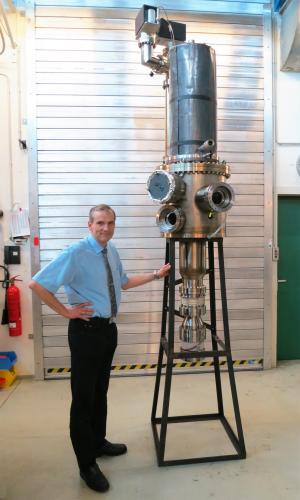R&D work on the European gyrotron progresses
17 May 2015
John Jelonnek, who is in charge of the KIT development program for the gyrotron, stands next to the 1 MW short-pulse prototype.
In ITER, energy-delivery devices called gyrotrons will contribute to heating the plasma to 150 million °C by generating high-frequency radio waves that transfer their energy to the plasma electrons. Four ITER Members—Europe, Japan, Russia and India—are responsible for delivering 24 ITER gyrotrons that will deliver a combined heating power of 24 MW.
The European Domestic Agency, with responsibility for six gyrotrons, is working with industry to develop the final design of the European gyrotron. Two industrial prototypes are currently in fabrication: a short-pulse gyrotron, capable of producing radio frequency of 1 MW for a few milliseconds; and a longer-pulse continuous-wave prototype, capable of producing a radiofrequency wave for several minutes.
In this development work, the European Domestic Agency is collaborating with the European Gyrotron Consortium—made up of the European fusion laboratories KIT (Germany), CRPP (Switzerland), HELLAS (Greece), and CNR (Italy), as well as the German USTUTT and Latvian ISSP as third parties—and Thales Electron Devices (France).
In parallel, a mockup of the cavity (the gyrotron subassembly where the radio frequency waves at 170 GHz will be generated) is currently under development in collaboration with Thales Electron Devices, with testing carried out at the FE200 high heat flux test facility of AREVA (France).
The work on the gyrotron prototypes and cavity mockup achieved a first milestone during a recent pre-validation meeting held for the most critical components and the scientific design of the gyrotron. The meeting, which was held in April, gathered representatives from the European Domestic Agency, the European Gyrotron Consortium, Thales Electron Devices and the ITER Organization. All R&D activities were considered to be fully successful, with the short-pulse gyrotron noted as producing an exceptionally good output beam of more than 1 MW at the required 170 GHz frequency (up to 1.4 MW has been achieved) in a broad operational domain.
A second milestone—the full validation of the gyrotron technical design—is expected to be achieved during the first half of 2016.
Read the full story on the European Domestic Agency website.


